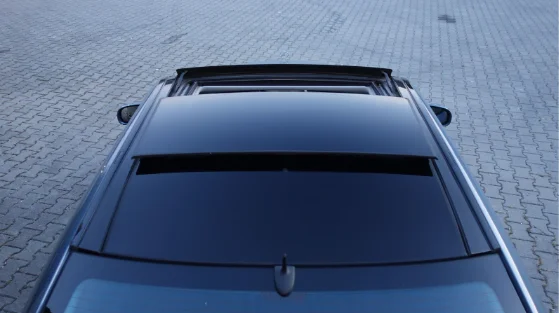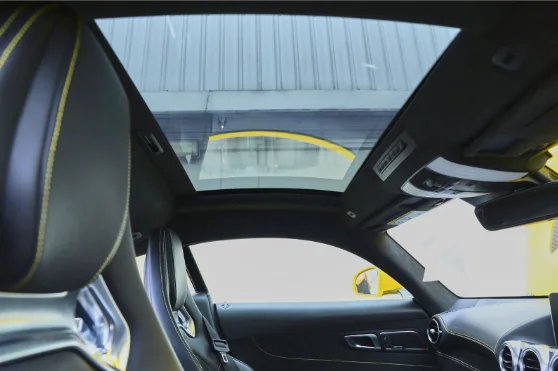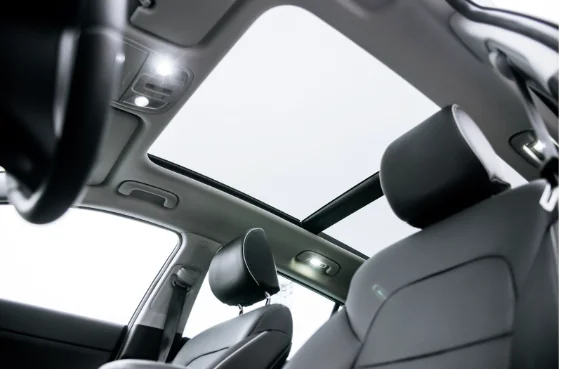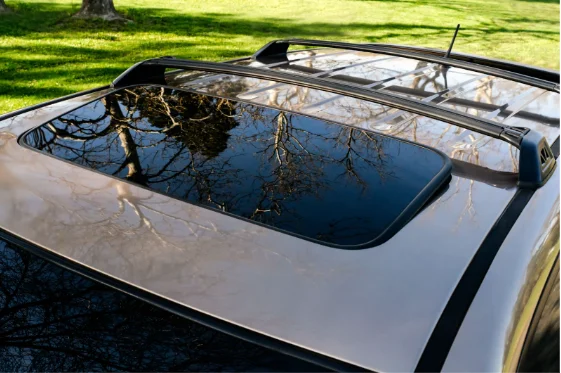In automotive design, the sunroof stands out as a feature that combines functionality with luxury, offering drivers and passengers a unique blend of open-air freedom and comfort. This article explores the nuances of sunroofs, moonroofs, and panoramic sunroofs, exploring their benefits, potential drawbacks, and how they have evolved to enhance the driving experience.
What is a Sunroof?
Traditionally, a sunroof is a metal or glass panel located on the roof of a car that can be opened to allow light and air into the vehicle’s cabin. Over the years, the sunroof has transitioned from being a metal panel to, more commonly, a glass panel, providing not just ventilation but also a view of the sky above, enriching the driving experience. With its capability to slide or vent, the sunroof has become a coveted feature in many late-model coupes and sedans, often listed as an extra feature at an additional cost.
Sunroof vs. Moonroof vs. Panoramic Sunroof
Sunroof:

- Can be made of metal or glass.
- Designed to open completely for ventilation and light.
Moonroof:

- Always a glass panel.
- May or may not open.
- Lets in light even when closed, with a sliding sunshade for bright days.
Panoramic Sunroof:

- An expansive glass panel covering front and back seats.
- Offers an immersive open-air feel.
- Opening may be limited due to size.
Pros and Cons of Sunroofs
Sunroofs are a sought-after feature for many drivers, enhancing the driving experience by blending the outdoor environment with the comfort of being inside a vehicle. They offer a taste of the convertible experience without the full exposure, making them a popular addition to many models. However, as with any feature, sunroofs come with their set of advantages and disadvantages.
Pros of Sunroofs:
- Adds a layer of luxury and comfort.
- Allows more light and air into the vehicle.
- Less commitment than a convertible.
Cons of Sunroofs:
- Potential waterproofing issues.
- Safety concerns, including distractions.
- Adds to the vehicle’s cost.
- Requires increased maintenance.
- Additional weight may affect handling and maneuverability.
- Extra entry points could raise security concerns.
Panoramic Sunroof Pros and Cons
Panoramic sunroofs elevate the traditional sunroof experience by providing expansive views and flooding the vehicle’s interior with natural light, making for a more spacious and open feeling. Ideal for those who crave a sense of freedom without opting for a convertible, panoramic sunroofs are a feature of modern automotive design that brings the outside in. Yet, this innovation has its challenges and considerations.
Pros of Panoramic Sunroofs:
- Offers greater exposure to natural light.
- Enhances the sense of spaciousness.
- Reduces the claustrophobic feel in closed cars.
Cons of Panoramic Sunroofs:
- It can increase cabin temperatures in warm weather.
- It may reduce headroom for passengers.
- Limited opening capability compared to traditional sunroofs.
Making an Informed Choice
Choosing between a sunroof, moonroof, or panoramic sunroof involves careful consideration of one’s needs and preferences. It’s essential to weigh the aesthetic and functional appeal against the practical implications, such as potential changes in vehicle dynamics, increased maintenance needs, and the impact on the vehicle’s overall value. Prospective buyers should assess how much value these features add to their driving experience versus the cost and potential issues that might arise.
Installation and Aftermarket Considerations
For those contemplating adding a sunroof or upgrading to a panoramic sunroof through aftermarket installation, it’s crucial to consider the costs, feasibility, and potential impact on the vehicle’s warranty and long-term value. Aftermarket installations can be expensive and might offer a different level of integration and reliability than factory-installed options.
Safety and Security Measures
Safety and security are paramount when it comes to vehicles equipped with sunroofs. Drivers should exercise caution and avoid distractions by operating the sunroof while the vehicle is in motion. Additionally, it’s important to be mindful of the security risks associated with having an additional entry point into the vehicle. Regular maintenance checks ensure the sunroof’s mechanical parts and seals remain in good condition, minimizing the risk of leaks and unauthorized access.
Summary
Sunroofs, moonroofs, and panoramic sunroofs each offer unique benefits that can enhance the driving experience by providing more light, air, and a sense of openness. However, these features also come with considerations, including costs, maintenance, and potential changes in vehicle dynamics.
By understanding the distinctions between these options and carefully considering their implications, drivers can make informed decisions that align with their preferences and lifestyle, ensuring their investment brings them joy rather than regret.
As the automotive industry continues to evolve, the integration of sunroofs and their variants into vehicle design highlights a continued desire for luxury and
FAQs
Are sunroofs safe in an accident?
Modern sunroofs are designed to meet safety standards, but like any glass in the vehicle, there’s a risk of breakage during an accident. Many are made with tempered or laminated glass for added safety.
Will a sunroof affect my car’s fuel efficiency?
The added weight and potential increase in aerodynamic drag could slightly reduce fuel efficiency. However, the impact is generally minimal for most vehicles
Can a sunroof be added to any car?
While many vehicles can accommodate an aftermarket sunroof installation, structural limitations and cost may vary widely. It’s essential to consult with a professional installer to assess the feasibility.
Do sunroofs come with a UV protection feature?
Many modern sunroofs and moonroofs are equipped with UV-protective glass to reduce sun exposure and keep the cabin cooler.
New tutenagency customers?
Quote auto insurance online or call (334) 502-5111 to insure your vehicle.
Disclaimer: This content is for informational purposes only and should not be considered legal or financial advice. Always consult with qualified professionals in legal and financial fields before making any decisions.

